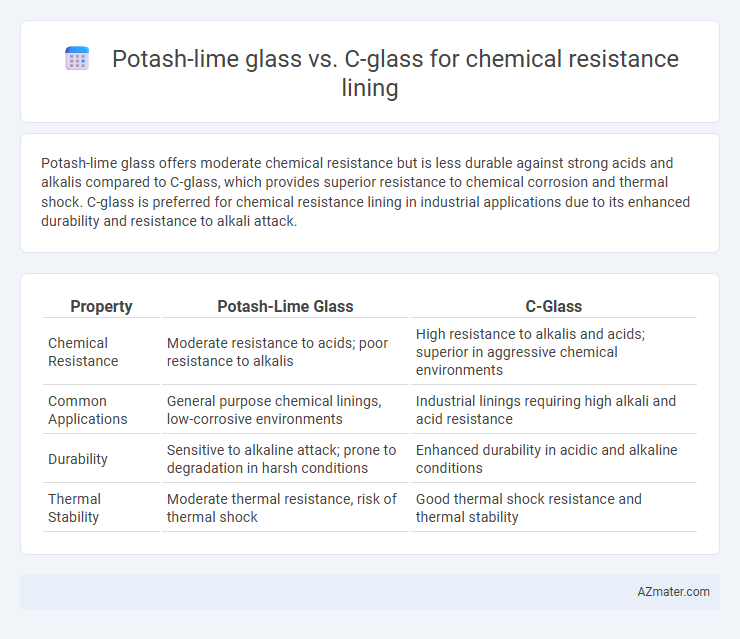Potash-lime glass offers moderate chemical resistance but is less durable against strong acids and alkalis compared to C-glass, which provides superior resistance to chemical corrosion and thermal shock. C-glass is preferred for chemical resistance lining in industrial applications due to its enhanced durability and resistance to alkali attack.
Table of Comparison
| Property | Potash-Lime Glass | C-Glass |
|---|---|---|
| Chemical Resistance | Moderate resistance to acids; poor resistance to alkalis | High resistance to alkalis and acids; superior in aggressive chemical environments |
| Common Applications | General purpose chemical linings, low-corrosive environments | Industrial linings requiring high alkali and acid resistance |
| Durability | Sensitive to alkaline attack; prone to degradation in harsh conditions | Enhanced durability in acidic and alkaline conditions |
| Thermal Stability | Moderate thermal resistance, risk of thermal shock | Good thermal shock resistance and thermal stability |
Introduction to Potash-Lime Glass and C-Glass
Potash-lime glass, primarily composed of potassium oxide and lime, offers moderate chemical resistance, making it suitable for general chemical lining applications where durability against alkalis and acids is required. C-glass, or chemical glass, contains boron oxide, which significantly enhances its resistance to chemical corrosion, especially in acidic environments, providing superior performance in aggressive chemical processes. The selection between potash-lime glass and C-glass depends on the specific chemical exposure conditions, with C-glass preferred for high-resistance needs in industrial chemical linings.
Chemical Composition: Potash-Lime Glass vs C-Glass
Potash-lime glass primarily consists of silica (SiO2), potash (K2O), lime (CaO), and smaller amounts of alumina (Al2O3), offering moderate chemical resistance but susceptibility to alkali attack. C-glass, or chemical glass, contains higher amounts of boron oxide (B2O3) and alumina, enhancing its resistance to acids and alkali, making it superior for chemical-resistant linings. The increased boron content in C-glass significantly improves durability against corrosive environments compared to the potash-lime composition.
Manufacturing Processes of Both Glass Types
Potash-lime glass manufacturing involves melting a mixture of sodium carbonate, lime, and silica at high temperatures, resulting in a composition with moderate chemical resistance suitable for general applications. C-glass, or chemical glass, is produced by refining borosilicate components with added alumina and silica through a controlled fusion process, enhancing its durability against corrosive chemicals. The precise formulation and melting techniques of C-glass yield superior chemical resistance linings compared to potash-lime glass, making it ideal for aggressive chemical environments.
Key Properties Relevant to Chemical Resistance
Potash-lime glass exhibits moderate chemical resistance with susceptibility to attack by alkaline and acidic solutions, whereas C-glass is specially formulated for enhanced chemical durability against acids, alkalis, and salts. The key properties of C-glass include higher alkali resistance due to boron oxide content and lower solubility in aggressive chemical environments compared to potash-lime glass. This makes C-glass a preferred lining material in applications requiring sustained exposure to corrosive agents and improved lifespan in chemical processing industries.
Comparison of Chemical Resistance in Corrosive Environments
Potash-lime glass exhibits moderate chemical resistance, performing adequately against alkalis but showing vulnerability to strong acids and hydrofluoric acid in corrosive environments. C-glass, formulated with high borosilicate content, offers superior resistance to alkaline substances, acids, and organic solvents, making it more reliable for chemical resistance lining in harsh industrial settings. The enhanced chemical durability of C-glass reduces corrosion-induced degradation, significantly extending the lifespan of linings exposed to aggressive chemical agents.
Thermal and Mechanical Stability Under Chemical Exposure
Potash-lime glass exhibits moderate chemical resistance but lower thermal and mechanical stability under prolonged chemical exposure compared to C-glass, which provides enhanced durability due to its higher boron oxide content. C-glass maintains structural integrity and resists thermal shock better, making it preferred for chemical resistance linings in aggressive environments requiring consistent performance. The superior mechanical strength and reduced susceptibility to alkali attack in C-glass optimize longevity and safety in industrial applications involving fluctuating temperatures and corrosive chemicals.
Typical Industrial Applications for Chemical Lining
Potash-lime glass is commonly used for chemical resistance lining in applications involving low to moderate chemical exposure, such as storage tanks, piping, and reactors handling acids like sulfuric and nitric acid. C-glass offers superior resistance to alkalis and is preferred in highly corrosive environments including chemical process equipment in chlor-alkali plants, caustic soda handling, and glass-reinforced plastic (GRP) linings exposed to alkaline solutions. Both materials provide robust protection but are selected based on specific chemical compatibilities to optimize longevity and performance in industrial chemical lining systems.
Cost and Availability Analysis
Potash-lime glass offers a lower initial cost and broader availability compared to C-glass, making it a cost-effective choice for chemical resistance linings in general applications. C-glass, while typically more expensive, provides superior chemical resistance and durability in highly corrosive environments, which may justify the higher investment for specialized industrial uses. Market availability for potash-lime glass remains more consistent globally, whereas C-glass supply can be limited and subject to regional manufacturing constraints, impacting project timelines and logistics.
Long-Term Performance and Maintenance
Potash-lime glass offers moderate chemical resistance but tends to degrade faster than C-glass when exposed to harsh chemicals over extended periods, impacting long-term performance in chemical resistance linings. C-glass, designed with higher silica content and enhanced chemical durability, provides superior resistance to alkalis and acids, ensuring longer service life with reduced maintenance requirements. The lower ion exchange and corrosion rates in C-glass minimize surface erosion and pitting, significantly enhancing the longevity and reliability of linings in industrial chemical environments.
Conclusion: Choosing the Right Glass for Chemical Resistance Lining
Potash-lime glass offers moderate chemical resistance suitable for low to moderate corrosive environments, while C-glass provides superior resistance against acids, alkalis, and moisture, making it ideal for harsh chemical linings. Selection depends on the specific chemical exposure, temperature conditions, and mechanical stress requirements; C-glass is preferred for aggressive chemical environments due to its enhanced durability and stability. Ultimately, understanding the chemical composition and application parameters ensures the optimal choice between potash-lime glass and C-glass for effective chemical resistant linings.

Infographic: Potash-lime glass vs C-glass for Chemical resistance lining
 azmater.com
azmater.com